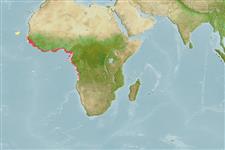| Native range | All suitable habitat | Point map | Year 2100 |

|
| This map was computer-generated and has not yet been reviewed. |
| Pseudotolithus senegallus AquaMaps Data sources: GBIF OBIS |
Issue
The species Pseudotolithus brachygnathus Bleeker, 1863 is considered as valid in Eschmeyer (CofF ver. Jul. 2010: Ref. 84883) according to Afonso et al. (1999: Ref. 34088).
Length at first maturity
Lm 30.3 range ? - ? cm
Utilização humana
Pescarias: pouco comercial; peixe desportivo: sim
Phylogenetic diversity index
(Ref. 82805)
PD50 = 0.5156 many relatives (e.g. carps) 0.5 - 2.0 few relatives (e.g. lungfishes)
Nível Trófico
(Ref. 69278)
3.9 ±0.67 se; Based on food items.
Resiliência
(Ref. 69278)
Baixo, tempo mínimo de duplicação da população 4,5 - 14 anos (Assuming tmax>10)